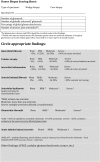Banff Histopathological Consensus Criteria for Preimplantation Kidney Biopsies
- PMID: 27333454
- PMCID: PMC6139430
- DOI: 10.1111/ajt.13929
Banff Histopathological Consensus Criteria for Preimplantation Kidney Biopsies
Abstract
The Banff working group on preimplantation biopsy was established to develop consensus criteria (best practice guidelines) for the interpretation of preimplantation kidney biopsies. Digitally scanned slides were used (i) to evaluate interobserver variability of histopathologic findings, comparing frozen sections with formalin-fixed, paraffin-embedded tissue of wedge and needle core biopsies, and (ii) to correlate consensus histopathologic findings with graft outcome in a cohort of biopsies from international medical centers. Intraclass correlations (ICCs) and univariable and multivariable statistical analyses were performed. Good to fair reproducibility was observed in semiquantitative scores for percentage of glomerulosclerosis, arterial intimal fibrosis and interstitial fibrosis on frozen wedge biopsies. Evaluation of frozen wedge and core biopsies was comparable for number of glomeruli, but needle biopsies showed worse ICCs for glomerulosclerosis, interstitial fibrosis and tubular atrophy. A consensus evaluation form is provided to help standardize the reporting of histopathologic lesions in donor biopsies. It should be recognized that histologic parameters may not correlate with graft outcome in studies based on organs deemed to be acceptable after careful clinical assessment. Significant limitations remain in the assessment of implantation biopsies.
Keywords: biopsy; clinical research/practice; donors and donation: deceased; kidney (allograft) function/dysfunction; kidney failure/injury; pathology/histopathology.
© Copyright 2016 The American Society of Transplantation and the American Society of Transplant Surgeons.
Figures
References
-
- OPTN/SRTR report 2008. Table 3.2. Available from: http://www.ustransplant.org.
-
- Policy 3.5: Organ Distribution: Allocation of deceased kidneys 6/20/2008. Policy 3.5.9.2: desirable information for kidney offers. Available from: http://optn.transplant.hrsa.gov/PoliciesandBylaws.
-
- Racusen LC, Solez K, Colvin RB, et al. The Banff 97 working classification of renal allograft pathology. Kidney Int 1999; 55: 713–723. - PubMed
-
- Solez K, Colvin RB, Racusen LC, et al. Banff 07 classification of renal allograft pathology: Updates and future directions. Am J Transplant 2008; 8: 753–760. - PubMed
Publication types
MeSH terms
LinkOut - more resources
Full Text Sources
Other Literature Sources
Medical



